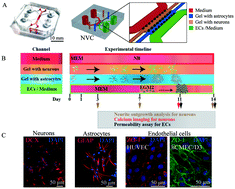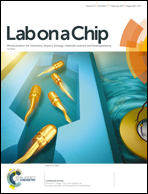A 3D neurovascular microfluidic model consisting of neurons, astrocytes and cerebral endothelial cells as a blood–brain barrier†
Abstract
The neurovascular unit is a complex, interdependent system composed of neurons and neural supporting cells, such as astrocytes, as well as cells that comprise the vascular system including endothelial cells, pericytes, and smooth muscle cells. Each cell type in the neurovascular unit plays an essential role, either in transmitting and processing neural signals or in maintaining the appropriate microenvironmental conditions for healthy neural function. In vitro neurovascular models can be useful for understanding the different roles and functions of the cells composing the neurovascular unit, as well as for assessing the effects on neural function of therapeutic compounds after crossing the endothelial barrier. Here, we report a novel three-dimensional neurovascular microfluidic model consisting of primary rat astrocytes and neurons together with human cerebral microvascular endothelial cells. These three cell types in our neurovascular chip (NVC) show distinct cell type-specific morphological characteristics and functional properties. In particular, morphological and functional analysis of neurons enables quantitative assessment of neuronal responses, while human cerebral endothelial cells form monolayers with size-selective permeability similar to existing in vitro blood–brain barrier (BBB) models.

- This article is part of the themed collection: Lab on a Chip 2017 Most Downloaded Articles

 Please wait while we load your content...
Please wait while we load your content...